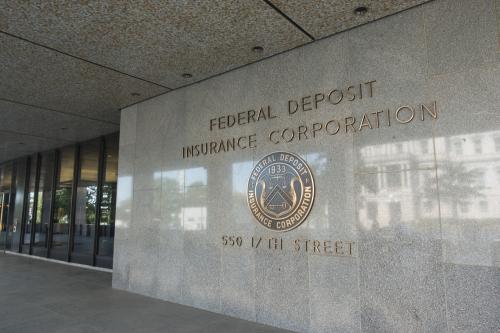When Silicon Valley Bank and Signature Bank failed in March, the Treasury, Federal Reserve, and Federal Deposit Insurance Corporation (FDIC), invoking a provision of law that applies when they determine the financial system is at risk, covered billions of dollars in deposits that were above the $250,000 legal ceiling on deposit insurance. That led to speculation that the government was, at least implicitly, lifting the deposit insurance ceiling. When First Republic failed in May, the FDIC reached an agreement with JPMorgan Chase that protected uninsured depositors. All this has sparked questions about the wisdom of the $250,000 per account ceiling on deposit insurance, which was the subject of a debate at the Hutchins Center on Fiscal & Monetary Policy at Brookings on April 5, moderated by CNBC’s Kelly Evans. The video and transcript of the debate is posted here. Below are some highlights.
Prasad Krishnamurthy (berkeley law): Why the ceiling on deposit insurance should be lifted
So-called uninsured deposits are actually insured. All of the deposits in Silicon Valley Bank and Signature Bank were insured after the fact. Neither of these banks was on the Federal Reserve’s radar as a systemically risky or important institution. So whether we like it or not, deposit insurance for the uninsured, it does exist, in fact, and it exists because policymakers have this commitment problem. Treasury Secretary Janet Yellen or Fed Chairman Jerome Powell or really anyone in their situation is always going to err on the side of insuring deposits when there is stress on the banking system because they’re afraid that depositors will just exit the banking system in mass and go and buy government bonds for safety. So given this undeniable implicit insurance, it makes sense to consider a more orderly and rational system of deposit insurance.
We could expand the existing system and cover many more deposits. The FDIC could assess a fee to all banks on the basis of their total deposits and any other factors that go into bank insolvency. We can do this in such a way so that smaller depositors would not be hurt and the brunt of the costs would fall on large depositors with explicit insurance. Bank depositors would not be able to threaten the stability of the banking system in a crisis. Instead, in a crisis, funds would flow into the banking system because of the insurance, and the Fed would be able to conduct monetary policy without worrying about interest rate moves that would trigger a banking panic.
PETER CONTI-BROWN (PENN WHARTON): Raise the Ceiling But Only for Small Businesses; Lower It for Others
Here’s what we know so far. We learned that some bankers are very bad at the basic business of banking. We learned that some bank supervisors, even when they identify this basic risk mismanagement, can be extremely slow to implement. And we learned that uninsured depositors are extremely flighty, and might be faster than ever before because of how easy it is on a smartphone to make those withdrawals. This makes regulators trigger-happy with declarations of banking crises, including the provision of government benefits to those who are not legally entitled to receive them.
There is one class of uninsured depositors whose flight is both systemically important and equitably important that require us to rethink the way that we do deposit insurance. That class of people and institutions are not multi-millionaires who have decided to park seven-, eight-, nine-figure deposits in a single bank. They’re also not large corporations that have so mismanaged their cash position that they’ve exposed themselves to colossal risk of bank failure by locating billions of dollars in a single account. They are very small businesses that are trying to find their way in the world and are using a cash management system that seems pretty straightforward. Right now, the law treats them identically to the very wealthy, and we should change that. If you are a small business that needs to meet a monthly or biweekly or even weekly payroll, then the $250,000 limit is probably extremely difficult to honor. And we should recognize this.
I advocate lowering the individual deposit insurance rate to $200,000 from $250,000 to send a signal that just because there is an implicit guarantee of all uninsured depositors, that does not mean that we need to make that guarantee explicit. And I would say that we should make it higher for small businesses, which will be tricky to define—at least five employees and no more than 100. We need to get better regulators who are willing to let market discipline do what it does so well, and to let people bear both the upsides of their risk but also the downsides from which the government has spared them. If we can do this, then we can send a signal that we’ve never seen before, and that is that government guarantees for depositors don’t simply move in a one-way upward ratchet as they have done historically.
PATRICIA MCCOY (boston college law): WHY RAISING THE CEILING ON DEPOSIT INSURANCE IS A BAD IDEA
Almost no country offers unlimited deposit insurance and those that did rolled it back. That’s because scrapping the cap is a very bad idea for at least four reasons.
The first is moral hazard—the concern that the mere presence of insurance will cause banks to gamble on reckless risks—and they bet that deposit insurance will cover the losses if the bank fails. Economists have repeatedly found that countries with higher deposit insurance coverage have a significantly greater likelihood and severity of financial crises. They’ve also concluded that the destabilizing future effect of this moral hazard outweighs the stabilizing effect of higher deposit insurance right now.
The second reason is that unlimited deposit insurance would require even stricter and fully consistent financial regulation. History has proven that our political system is incapable of that. We have periods of strict deregulation and then we have rollbacks, as we have seen in the past few years. This lack of political will has grown worse with the growing political might of banks, and banks are already pushing back against tighter regulation.
The third reason is that calls for unlimited deposit insurance are premature. There are other ways to protect uninsured depositors if more banks fail now. Normally, during bank failures, uninsured depositors are protected through something known as purchase and assumption agreements. These are mergers where a healthy bank honors all the deposits of the failed bank (as JPMorgan Chase did for depositors at First Republic). Now, why didn’t we have these agreements for Signature Bank and Silicon Valley Bank? The big reason was because they had such a high level of uninsured deposits, ranging between 88% and 90%. So instead of lifting the cap, we should limit the ratio of uninsured deposits to assets and increase regulation of banks similar in size to those two banks.
We should also focus on private solutions to cash management for larger depositors. Uninsured depositors have not taken avail of these market solutions as fully as they should have, but they’re out there. One example consists of deposit sweep programs that allows companies to park their deposits at multiple banks, while only dealing with one bank. Businesses can also use treasury management services and lines of credit at other banks.
Finally, and this is a big concern, can the U.S. afford total coverage, and who will pay for it? Right now, banks pay for deposit insurance through premiums. If we got rid of the deposit insurance cap first, would banks be able to pay sufficient premiums to cover all the deposits? And second, would they be willing to pay those higher premiums? Already, banks are resisting having to pay the special assessment to cover 100% coverage at SVP and Signature Bank. Imagine their reaction if they had to pay for 100% coverage at every bank. Also note deposit insurance premiums are chronically underpriced and don’t capture the increased systemic risk from 100% coverage. So even if banks are willing to pay higher premiums, they still would not be paying enough. If banks don’t step up to finance this increase, then let’s be clear it will be borne by taxpayers, including ordinary working families. And if banks do step up, we will be paying higher bank fees anyhow.
PRASAD KRISHNAMURTHY: ABOUT THAT MORAL HAZARD CONCERN…
Now, the most important criticism of this expanding deposit insurance trade is that the banking system would actually become less safe because depositors would now ignore risk, and banks would take advantage of the cheap funding that they would get in. Banks would become riskier. This phenomenon is known as moral hazard, and it’s the phenomenon of when you will ignore risk whenever you’re insured against it. And this is a real concern. But I think there are a number of steps that could be taken that could mitigate this briefly. First, banks would need enough capital and they would need enough subordinated debt to make sure that those instruments would have absorbed the first losses in the wake of a banking crisis. And so the depositors would be substantially subordinated in the bank’s financial structure. Second, regulators would need to assign insurance premiums that were based both on regulatory measures of risk and on market-based measures of risk.
THOMAS PHILIPPON (NYu stern): Distinguish between households and small businesses
Just because some moronic bankers in a medium-sized bank completely failed at the basic risk management, the idea that because of that one data point, you’re going to change the entire system for most of the industries who did not make these mistakes strikes me as a little bit of a stretch. From a European perspective, the U.S. did exactly what the U.S. was making fun of Europeans for doing ten years ago, which is no depositor left behind—even those who were not actually insured. Also, banks already have a large funding advantage in that the deposit insurance is underpriced. Extending that is a bad idea.
But doesn’t mean nothing should be changed. You have to distinguish between transaction accounts and savings accounts. Transaction accounts are what people use to make payments every day. And then the question is, how big should the insurance card be? For households, $250,000 is just way more than enough. The 90th percentile of deposit distribution in the U.S. is like $60,000.
The issue is with small- and medium-sized enterprises (SMEs). In Europe, when I was in government ten years ago during the banking crisis, we had exactly that same issue with the banks in Cyprus failing, and they had large money from, in part, rich households in bulk from rich Russian oligarchs—they were all above the €100,000 limit. And we didn’t want to insure these guys. The issue, of course, was that if you do it with one size fits all, you’re also going to get some SMEs caught in that process who have higher deposit transaction accounts because they need them to make payrolls. The solution is to treat these guys differently from large or small depositors. It does make sense to have a different role for SMEs because it is too dangerous to put limits on SME accounts that are used to make payrolls.
One option—the one Peter Conti-Brown suggests—is to have a $200,000 ceiling for your average family and $2 million for your typical SME. In Europe, we didn’t do that. We said that in case of resolution or recovery, SME deposits have priority over other deposits. And so, take the case of SVB. The problem is that you had to bail out everybody and lose $18 billion in order to protect just the SME accounts. But there’s a simple solution: Don’t treat them all the same. You say that what we’re going to do is: first, that the insured guys are paid out, of course, 100%. And then next, the SME deposits. They have priority over wealthy household deposits. I’m not sure which option is best at that point, to be honest.
The Brookings Institution is financed through the support of a diverse array of foundations, corporations, governments, individuals, as well as an endowment. A list of donors can be found in our annual reports published online here. The findings, interpretations, and conclusions in this report are solely those of its author(s) and are not influenced by any donation.
The Brookings Institution is committed to quality, independence, and impact.
We are supported by a diverse array of funders. In line with our values and policies, each Brookings publication represents the sole views of its author(s).





Commentary
A debate: Should the US raise the $250,000 ceiling on deposit insurance?
May 2, 2023